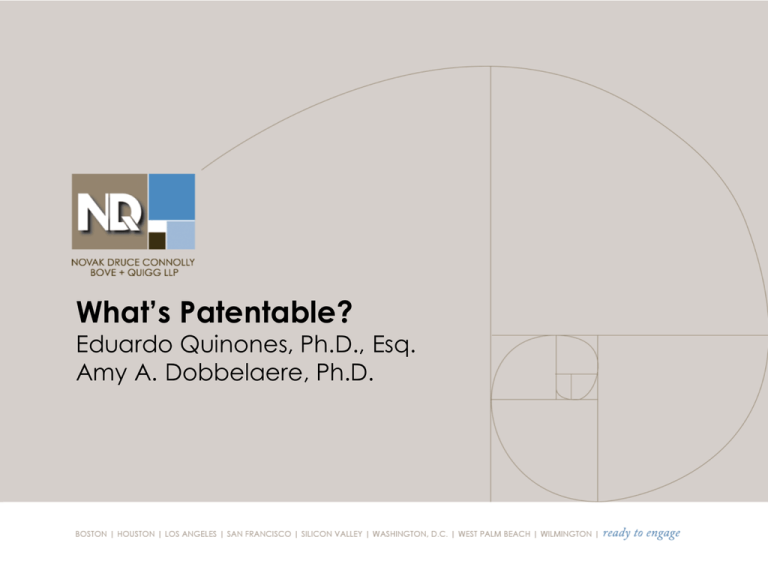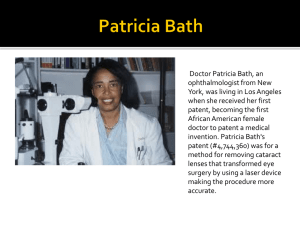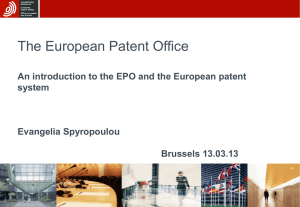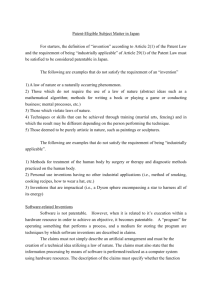here
advertisement

What’s Patentable? Eduardo Quinones, Ph.D., Esq. Amy A. Dobbelaere, Ph.D. WHAT IS A PATENT? • A patent is a property right – Prevents others from making, using or selling your invention without your permission – Exclusionary Right – One Patent – One Jurisdiction TYPES OF PATENTS Design Plant Utility For today, we will focus on Utility Patents TYPES OF UTILITY APPLICATIONS • In the United States – Provisional Applications – Non-provisional Applications • Around the world – Patent Cooperation Treaty (PCT) Application and National Stage Filings – Direct National Filings • Timing – File first application before your first public disclosure* – File subsequent applications around the world within a year or country-specific deadlines for PCT. SO WHAT CAN I PATENT? 35 U.S.C. 101: Whoever invents or discovers any new and useful process, machine, manufacture, or composition of matter, or any new and useful improvement thereof, may obtain a patent therefore, subject to the conditions and requirements of this title. Inventions must be new, useful, and non-obvious Around the world: New, involve an inventive step (~non-obvious), and have industrial applicability (~useful) TYPES OF INVENTIONS • “Engineering” – Mechanical, Electrical, Chemical, Software or combinations thereof – Usually protecting: • Devices/systems or components thereof • Methods of operation, use, or manufacture • Biotechnology Inventions – Molecular biology, Gene therapy, Virology, Genetics, Immunology, Stem cell technology, etc. – Usually protecting: • Compositions, methods of making & using • Diagnostic kits/methods • Transgenic organisms PATENT APPLICATION PROCESS • Prepare invention disclosure or other materials to share with patent professional • Patent professional prepares application* – Specification/Description – Drawings – Claims • Application is filed • Examination • Allowance • Patent is Issued! • Total time – Several years PATENTABILITY REQUIREMENTS IN THE U.S. • In the U.S., application will generally be examined to ensure compliance with: – 35 U.S.C. 101 – Something that can be patented? – 35 U.S.C. 102 – Is it new in view of the prior art? – 35 U.S.C. 103 – Is it non-obvious in view of the prior art? – 35 U.S.C. 112 – Does the application have • (1) An adequate description of the invention? • (2) Enough details to practice the invention? PATENTABILITY REQUIREMENTS IN THE U.S. (Cont’d) • Most Engineering-type inventions – Typically straightforward to describe and claim in application – Examination typically limited to claim form in view of prior art • However, certain types of inventions require additional considerations: – Biotech inventions – Software inventions CONSIDERATIONS FOR BIOTECH PATENT APPLICATIONS TYPICAL BIOTECH PATENT APPLICATION/PATENT • Description and Figures ― As detailed a description as possible, including examples of several embodiments for a given invention ― In the ‘Examples’ section, inclusion of all relevant data, in vivo data always preferred ― Data figures • Claims ― Composition consisting of or comprising… ― Method of treating disease X in a subject comprising administering the composition… ― Method of making a composition comprising…, the method comprising the steps of: a, b and c ― Method for analyzing X in a sample… ― A kit for analyzing X or treating disease X… BIOTECH PATENTS AROUND THE WORLD • In EPO, plant & animal varieties & biological processes for production thereof, methods for treatment of the human or animal body by surgery or therapy & diagnostic methods practiced on the human or animal body not patentable • In EPO, patenting of stem cells is controversial – EPO does not process stem cell applications while the UK & DE patent offices follow a less stringent approach • In JPO, methods to treat humans, specifically through surgery, general treatment, or diagnosis are not patentable. • In Canada, methods of medical treatment & higher life forms are not patentable BIOTECH PATENTS AROUND THE WORLD (cont.) • U.S. patent rules provide applicants with relatively flexible rules for amending claims during patent prosecution. • EP in particular has more stringent claim support requirements – EP examiners typically don’t allow cobbling together an amended claim out of different embodiments. In EP, providing numerous embodiments of a given invention is a necessity, & describing how to combine various features of the disclosed embodiments may also be. • China and Australia moving in EP’s direction • JPO strictly requires that patent applications claiming medical uses (pharmaceutical inventions) should disclose "pharmacological test data or the equivalent" in the specification. BIOTECH PATENTS IN THE U.S. • The USPTO considers non-naturally occurring, nonhuman multicellular organisms, including animals, to be patentable subject matter ― Microorganisms (bacteria, yeast, fungi) ― Embryonic stem cells ― Plants ― Animals ― Cellular / Biological Processes ― Genes and Nucleotide Sequences ― Gene Products (proteins) ― Biologically Derived Chemicals / Pharmaceuticals ― Diagnostic reagents ― Methods of treatment ― Medical Devices BIOTECH PATENTS IN THE U.S. (cont.) • Recent Case Law/Issues ― 2012 - Mayo Collaborative Services v. Prometheus Laboratories, Inc. ― 2013 – Ass’n for Molecular Pathology v. Myriad Genetics ― 2014 – AbbVie v. Janssen Biotech and Centocor Biologics ― Higher enablement (35 U.S.C. 112) standard compared to other fields ― Experimental data very important in many cases, in vivo more compelling than in vitro, e.g., claims for ‘method of preventing…’ & vaccines require substantial in vivo data for support CONSIDERATIONS FOR SOFTWARE PATENT APPLICATIONS PATENTING SOFTWARE • Generally two main aspects for any type of software: – Algorithms, methods, and other general concepts that describe, at a high level, how the software operates; and – Actual computer code for implementing these concepts. • Patents - Target the high level concepts • Other types of protection are typically used for computer code (e.g., Copyright) TYPICAL SOFTWARE-BASED PATENT • Description and Drawings: – Operating Environment – Particular/specialized components – Flow charts for each process – General Computer description/schematic • Claims – Method – Computer-Product Claims – System Claims EXAMPLE OF SOFTWARE PATENT SOFTWARE PATENTS AROUND THE WORLD • Outside the U.S., obtaining software-based patents can be difficult: – Excluded by law; or – Excluded by problem/solution examination • Problem/Solution Examination requires determining: – Problem being solved A technical one?; – Solution being claimed: • Would it be obvious to adapt the closest prior art to provide the solution? • Does solution provides a technical effect or advantage over the closest prior art.* • Thus, completely new software methods may be unpatentable overseas unless one can demonstrate a tangible, technical advantage of the method or system implementing the method. 20 SOFTWARE PATENTS IN THE U.S. • Patents can be obtained for software-based inventions in the U.S. – Software per se is not patentable in the U.S. – However, methods implementing software-based inventions or articles of manufacture implementing such methods may be patentable • To a major extent, examination is straight forward • However, recent developments have imposed additional requirements MAIN ISSUE - IS A SOFTWARE-BASED INVENTION ELIGIBLE FOR PATENT PROTECTION? • 35 U.S.C. 101: Whoever invents or discovers any new and useful process, machine, manufacture, or composition of matter, or any new and useful improvement thereof, may obtain a patent therefor, subject to the conditions and requirements of this title. • Pre-2010 – Machine or Transformation (MT) Test • 2010 - Bilski V. Kappos – MT test not sole measure of patentability. • 2014 - Alice v. CLS - Claims directed to an abstract idea or a generic computer implementation of an abstract idea are ineligible for patent protection SOFTWARE-BASED PATENTS AFTER ALICE V. CLS? • USPTO Examination (still developing) (1) Is the claim directed to an abstract idea? (2) If so, are there other claim features that show a patent-eligible application of the abstract idea, e.g., more than a mere instruction to apply the abstract idea? • What does this mean? – Does the claim recite a way to use the abstract idea solve a technical problem?; or – Does the abstract idea provide some type of technical advantage? • In sum a problem/solution or technical step type approach to determine patent eligibility – No clear guidance yet, but consistent with Post-Alice decisions SO WHAT DO YOU NEED TO DO? • Invention disclosures – Don’t limit description to just the software and how it works – Describe, in detail, technical problems solved by the software or a system implementing the software – Describe, in detail, any technical advantages of using the software • e.g., improved computational speed, reduced memory demands, not just a business advantage. • Working with patent professionals – Read draft applications in their entirety (you are supposed to do so anyways!) and make sure technical advantages and/or technical problems solved by the software are discussed as fully as possible. CONTACT INFORMATION Eduardo Quinones, Ph.D., Esq. eduardo.quinones@novakdruce.com (561)847-7822 Amy A. Dobbelaere, Ph.D. amy.dobbelaere@novakdruce.com (561)847-7809 Novak Druce Connolly Bove + Quigg LLP Cityplace Tower, 15th Floor 525 Okeechobee Blvd West Palm Beach, FL 33401 www.novakdruce.com Questions?







